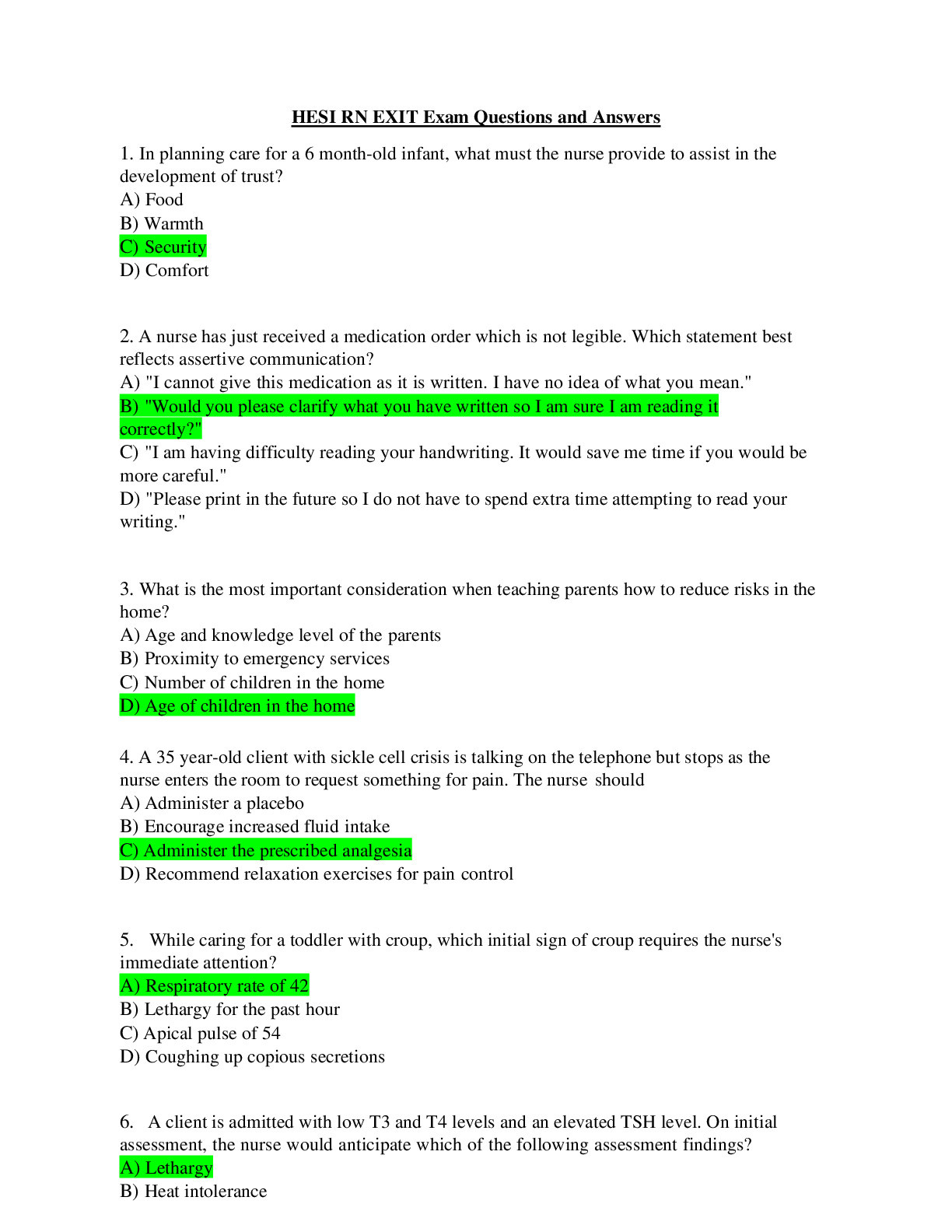All study resources > hesi-rn-exit-exam-questions-and-answers (Nursing)
hesi-rn-exit-exam-questions-and-answers
1. In planning care for a 6 month-old infant, what must the nurse provide to assist in the development of trust?
A) Food
B) Warmth C) Security
D) Comfort
2. A nurse has just received a medication order which is not legible. Which statement best reflects assertive communication?
A) "I cannot give this medication as it is written. I have no idea of what you mean." B) "Would you please clarify w
...[Show More]
1. In planning care for a 6 month-old infant, what must the nurse provide to assist in the development of trust?
A) Food
B) Warmth C) Security
D) Comfort
2. A nurse has just received a medication order which is not legible. Which statement best reflects assertive communication?
A) "I cannot give this medication as it is written. I have no idea of what you mean." B) "Would you please clarify what you have written so I am sure I am reading it correctly?"
C) "I am having difficulty reading your handwriting. It would save me time if you would be more careful."
D) "Please print in the future so I do not have to spend extra time attempting to read your writing."
3. What is the most important consideration when teaching parents how to reduce risks in the home?
A) Age and knowledge level of the parents
B) Proximity to emergency services
C) Number of children in the home D) Age of children in the home
4. A 35 year-old client with sickle cell crisis is talking on the telephone but stops as the nurse enters the room to request something for pain. The nurse should
A) Administer a placebo
B) Encourage increased fluid intake C) Administer the prescribed analgesia
D) Recommend relaxation exercises for pain control
5. While caring for a toddler with croup, which initial sign of croup requires the nurse's immediate attention? A) Respiratory rate of 42
B) Lethargy for the past hour
C) Apical pulse of 54
D) Coughing up copious secretions
6. A client is admitted with low T3 and T4 levels and an elevated TSH level. On initial assessment, the nurse would anticipate which of the following assessment findings? A) Lethargy
B) Heat intolerance
C) Diarrhea
D) Skin eruptions
7. The emergency room nurse admits a child who experienced a seizure at school. The father comments that this is the first occurrence, and denies any family history of epilepsy. What is the best response by the nurse?
A) "Do not worry. Epilepsy can be treated with medications." B) "The seizure may or may not mean your child has epilepsy."
C) "Since this was the first convulsion, it may not happen again."
D) "Long term treatment will prevent future seizures."
8. Alcohol and drug abuse impairs judgment and increases risk taking behavior. What nursing diagnosis best applies? A) Risk for injury
B) Risk for knowledge deficit
C) Altered thought process
D) Disturbance in self-esteem
9. Which these findings would the nurse more closely associate with anemia in a 10 month-old infant?
A) Hemoglobin level of 12 g/dI B) Pale mucosa of the eyelids and lips
C) Hypoactivity
D) A heart rate between 140 to 160
10. The nurse is caring for a client in hypertensive crisis in an intensive care unit. The priority assessment in the first hour of care is
A) Heart rate
B) Pedal pulses
C) Lung sounds D) Pupil responses
11. Which of these clients who are all in the terminal stage of cancer is least appropriate to suggest the use of patient controlled analgesia (PCA) with a pump?
A) A young adult with a history of Down's syndrome
B) A teenager who reads at a 4th grade level
C) An elderly client with numerous arthritic nodules on the hands D) A preschooler with intermittent episodes of alertness
12. The nurse is about to assess a 6 month-old child with nonorganic failure-to thrive
(NOFTT). Upon entering the room, the nurse would expect the baby to be
A) Irritable and "colicky" with no attempts to pull to standing
B) Alert, laughing and playing with a rattle, sitting with support
C) Skin color dusky with poor skin turgor over abdomen D) Pale, thin arms and legs, uninterested in surroundings
[Show Less]
